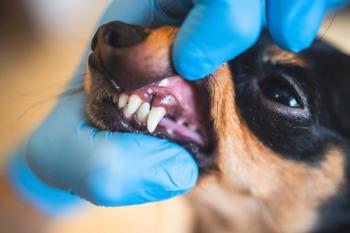
An update on periodontal disease in dogs (Proceedings)
Periodontal disease is probably the most common disease in dogs.1 Most dogs greater than 5 years of age have significant periodontitis.
Periodontal disease is probably the most common disease in dogs.1 Most dogs greater than 5 years of age have significant periodontitis. Periodontal disease increases significantly with increasing age, and decreases significantly with increasing body weight and is particularly obvious when comparing toy and small dogs with medium and large dogs.2 Periodontal disease is caused by the accumulation of bacteria in the form of plaque on the surface of the teeth which results in gingival inflammation and if left untreated results in the destruction of periodontal tissues which can result in clinically significant local and systemic problems. Periodontal disease occurs in two forms gingivitis and periodontitis. Gingivitis is a reversible inflammation of the gingiva. Periodontitis involves deeper inflammation with loss of tooth support and permanent damage. The purpose of periodontal therapy is to prevent gingivitis from progressing to periodontitis and to delay the progression of periodontitis once it is established.
Systemic antibiotics are not recommended for the routine prevention of periodontal disease, nor are they recommended for routine scaling of healthy dogs teeth without periodontal disease.4 However, perioperative antibiotics are recommended in animals with moderate to severe periodontitis, patients with painful oral ulcerations, animals who do not receive any home oral hygiene, those with systemic disease that may be worsened by bacteremia (turbulent blood flow caused by heart valve lesions or chronic renal failure), and patients undergoing concurrent clean or clean-contaminated surgical procedures.4 The antimicrobial of choice for clinical use in dogs with periodontal disease is Clavamox.3 The length of time recommended for the perioperative administration of antimicrobials varies from 2 to 10 days depending on the severity of periodontal disease. Perioperative antibiotics should be administered so that a therapeutic blood level is obtained prior to induction of the bacteremia caused by the dental therapy.
Stages of Periodontal Disease
In Stage 1 (gingivitis) periodontal disease, gingivitis with no attachment loss is present. Some dogs may have significant dental calculus with minimal gingivitis while others may have severe inflammation with minimal plaque and calculus. This stage of periodontal disease results in inflammation, edema, plaque and calculus accumulation, possible bleeding on probing, and possible pseudopocket formation.5 In Stage 2 (early) periodontal disease, the initial signs of destructive periodontitis are evident. Periodontal probing and radiographic examination may indicate attachment loss of up to 25%, teeth remain stable and pocket depths of 3-5mm are present.6 In Stage 3 (moderate) periodontal disease, the probing and radiographic signs of attachment loss are between 25% and 50% of the root length.6 Probing depths of 6-9 mm may be present with the presence of vertical defects and infrabony pockets. If gingival recession ispresent there may be only a minimal increase in probing depth indicating the importance of assessing attachment loss not only by pocket depth but also by measuring attachment loss from the cementoenamel junction to the depth of the periodontal pocket. Teeth may be mobile. In Stage 4 (severe) periodontal disease, the attachment loss is greater than 50%, there is severe loss of supporting tooth structures and pocket depths are greater than 9mm and teeth become loose. Significant infrabony pockets may be localized to a single area, such as the deep palatal pockets seen in maxillary canine teeth.
Diagnosis of the various stages of periodontal disease is based on a thorough oral examination, periodontal examination with a periodontal probe, and dental radiography. Animals with gingivitis, the reversible form of periodontal disease, have a swollen gingival margin that will bleed after the application of light pressure. Serous or purulent exudate is produced from the gingival sulcus. Halitosis is commonly present. Periodontal examination with a periodontal probe is normal and radiographically there is no evidence of bone loss around the teeth. Periodontitis in dogs is usually characterized by hyperplasia, gingival recession and pocket formation which progresses to tooth loss if untreated. Severe gingival inflammation with various amounts of calculus and debris are present with periodontitis. Periodontal probing will reveal the presence of periodontal pockets. Dental radiographs will reveal bone loss which is associated with periodontal disease. Bone loss may be horizontal or vertical. Horizontal bone loss is bone loss parallel to the cementoenamel junction which separates the anatomic crown from the anatomic root. Vertical bone loss is bone loss parallel to the long axis of the root.
Treatment of Periodontal Disease
Ideally the prevention of periodontal disease is preferred over the treatment of already established periodontal disease. Dogs can manage well without teeth, in fact dogs with very severe periodontal disease are better off without teeth because loss of diseased teeth is the most dependable way to eliminate this source of chronic infection.1 However, teeth should be retained whenever practical for functional and aesthetic reasons.1 It is recommended that occluding pairs of teeth particularly, the carnassial teeth or the canine (and maxillary third incisor) teeth be retained as functional units whenever practical. The treatment of periodontal disease includes a variety of techniques including: supragingival and subgingival scaling, root planing, subgingival curettage, polishing, gingivectomy, open-flap curettage and augmentation of boney defects, utilization of perioceutics, periodontopathogen vaccine, extraction, oronasal fistula repair, and home care.
Supragingival Scaling
Supragingival scaling refers to the removal of dental calculus above the gingival margin. This is most easily accomplished in small animals utilizing power scalers. In a recent study the efficacy with which four different power scalers (ultrasonic magneto-strictive, sonic, ultrasonic piezoelectric, and rotosonic scalers) removed dental calculus in the dog was compared.6 The ultrasonic piezo electric scaler removed calculus significantly faster than all the other power scalers. The ultrasonic magnetostrictive scaler was faster in the removal of calculus than the sonic scaler and the sonic scaler was faster in the removal of calculus than the rotopro scaler. Electron microscopy of teeth scaled were all similar except the teeth that were instrumented with the rotosonic scaler. The surface of the enamel of these teeth contained multiple deep groves.
Prior to ultrasonic scaling the patient's mouth is lavaged with a 0.12% chlorhexidine solution to reduce external bacterial counts. Gross calculus is gently removed with an extraction forceps by gently closing the forceps across the calculus. A power scaler is used to remove the remaining plaque, calculus, and debrie. Adequate water flow is essential when using power scalers to cool the oscillating tip and flush away the debris. The side of a sickle-shaped scaling tip is placed on the tooth surface and moved gently and continuously over the tooth surface. Continuous scaling of any one tooth for more than 15 seconds must be avoided to prevent pulp tissue injury from excessive heat and potential production of subsequent pulpal necrosis.
Subgingival Scaling
Subgingival scaling removes debris that has accumulated below the gingival margin which causes inflammation of the supporting structures of the teeth. Failure to remove subgingival calculus promotes the progression of periodontal disease. Historically subgingival calculus has been removed with a curette. The instrument is inserted with the face of the blade flush against the tooth. When the instrument reaches the bottom of the pocket the working angulation of the instrument, usually 45 degrees, is established. The instrument is then pushed against the tooth and pulled coronally. This process is repeated until all subgingival calculus is removed. Root planing is the smoothing of the root surface using curettes. This procedure is not a distinct entity from subgingival scaling or cleaning of the root surfaces but rather a continuation of the process. When the root is adequately planed it should feel smooth and hard like glass. Alternatively specially designed periodontal ultrasonic scaling instrumentation with ultrasonic periodontal scaling tips made for subgingival scaling can be used. These tips are designed to be used at a low power setting for delicate root treatment. These tips are more efficient and effective in cleaning the root surface and helps prevent user fatigue.
Subgingival Curettage
Subgingival curettage is the removal of diseased soft tissue from the periodontal pocket. While one edge of the curet engages the root surface, the other edge engages the soft tissues of the periodontal pocket. Although this process is often not thought of as a deliberate procedure it removes the diseased soft tissue portion of the periodontal pocket. The specially designed periodontal ultrasonic scaling tips can be used for this purpose.
Polishing
After the removal of all calculus the teeth are polished with a rubber cup placed on a prophylaxis angle attached to a slow-speed handpiece. Prophy paste is placed on the teeth and the cup is rotated over all tooth surfaces at a low speed. The cup is then pressed gently but firmly at the gingival margin to permit polishing of the root surface adjacent to the crown.
Irrigation
After polishing, the gingival sulcus is irrigated with a 0.12% chlorhexidine solution using a blunted 23-gauge needle and a 12 ml syringe. Irrigation of the gingival sulcus removes loose calculus, prophy paste and debris and reduces the bacterial counts.
Gingivectomy
Gingivectomy is the removal of gingival pockets by the excision of gingiva. There are several indications for gingivectomy including the following: gingival hypertrophy or hyperplasia, excisional or incisional gingival biopsy, elimination of shallow supraboney pockets with retention of adequate attached gingiva. A gingivectomy is performed by measuring the depth of the periodontal pocket and marking the depth of the pocket with the tip of the periodontal probe by pressing it into the gingiva perpendicular to the tooth to create a bleeding point. This is repeated every few millimeters to mark the pocket depth. A No. 15 blade is used to create a beveled incision starting 1 to 3 mm apical to the bleeding points (depending on the thickness of the gingiva) to produce an anatomically correct gingival margin.
Open-Flap Curettage and Augmentation of Boney Defects
Open-flap curettage is indicated in cases of periodontal disease in which pockets are greater than 5-6 mm deep and do not respond to conservative therapy. The purpose of flap surgery is to reflect soft tissue and gain access to deeper periodontal structures which can then be more thoroughly treated with the benefit of direct visualization. The most common indication in dogs for open-flap curettage and augmentation of periodontal boney defects are deep periodontal defects on the palatal aspect of the maxillary canine teeth. To repair a deep palatal periodontal defect a semilunar flap from the palatal surface of the affected canine tooth is raised four millimeters palatal to the edge of the boney defect. The periodontal pocket is debrided with a currette removing all calculus, granulation tissue, and debris. The area is flushed with 0.12% chlorhexidine solution then saline. A bulk matrix osseous replacement packing material which generally consists of small particulate granules can be placed in the defect in the hopes that they will be incorporated as a matrix into the initial blood clot that is subsequently replaced by supportive tissue, either bone or periodontal ligament, while deterring the ingrowth of gingival epithelium and connective tissue. 7 A bulk matrix osseous replacement packing material available in the veterinary market is Consil (Nutramax Labs). Freeze-dried canine or feline bone may also be used. Osteo Allograft™ Periomix is freeze-dried natural animal bone preserved using lyophilization to reduce the water content of the tissues and minimize structural changes to proteins. This product provides native growth factors and scaffolding to help promote optimal bone healing. This product can be used in a wide variety of cases to help reverse the bone loss associated with periodontitis including placement in boney pockets, placement in extraction sites and placement at jaw fracture sites to promote bone healing. After placement of the bone graft material into the defect the palatal gingival flap is sutured in place with 5-0 absorbable suture material such as Monocryl or Vicryl Rapide adapting the flap closely to the underlying bone and tooth with as little tension as possible. The treated palatal defect should be reexamined in 6 months. Results are usually excellent with complete elimination of the periodontal pocket in most cases.
Another common site for the development of deep periodontal pockets in dogs is between the mandibular 1st and 2nd molars. If the bone loss is extensive along the mesial root of the 2nd molar and the client is unwilling or unable to provide adequate home care, selective extraction of the 2nd molar with placement of Osteo Allograft™ Periomix in the extraction site and along the distal root of the 1st molar will stimulate new bone formation along this root. Alternatively, if the pocket between the mandibular 1st and 2nd molars is not approaching the apex of the mesial root of the mandibular 1st molar a flap can be raised around these teeth, the roots can be scaled, root planed, polished and rinsed and the Osteo Allograft™ Periomix can be placed in the defect. Other periodontal pockets can be treated with this regiment.
Perioceutics
Perioceutics are pharmaceutical formulations that are placed into or near the gingival sulcus or pocket around a tooth to provide some form of treatment for periodontitis and periodontal disease, resulting in some degree of periodontium rejuvenation.7 Doxirobe is a flowable doxycycline solution that is applied directly into the periodontal pocket of dogs by the use of a syringe and blunt-tip periodontal needle.
Periodontopathogen Vaccine
The development of a trivalent canine periodontitis vaccine has provided veterinarians with an additional treatment option in the management of canine periodontitis. Incorporation of this vaccine into a treatment plan may help prevent periodontitis in dogs
Extraction of Teeth with Periodontal Disease
The most common reason for extracting teeth with periodontal disease is Stage IV or severe periodontal disease. Teeth with less than 20-30% of remaining bone height have a poor prognosis. Extraction is recommended in those teeth in which the periodontal pocket has reached the apex of at least one root of a multirooted tooth. Animals with Stage III or moderate periodontal disease in which the client is unwilling or unable to provide appropriate periodontal care may be candidates for exodontia rather than advanced periodontic treatment regimens. Also those animals that may not be good candidates for multiple anesthetic episodes, or have severe mucogingival disease may benefit from exodontia versus advanced periodontic therapeutic techniques. Owner preference should also be considered when determining the most appropriate treatment protocol for a particular patient.
Oronasal Fistula Repair
Oronasal and oroantral fistulas are most frequently caused by advanced periodontal disease. Signs associated with oronasal and oroantral fistulas include sneezing and mucopurulent or hemorrhagic nasal discharge. The most common location of oronasal fistulas in the dog is the palatal aspect of the maxillary canine tooth. Other teeth that can potentially cause oronasal fistulas are the maxillary incisors and maxillary premolars and molars. Teeth affected with Stage IV periodontal disease should be removed and the oronasal or oroantral fistula should be repaired with a mucoperiosteal flap.
Home Care
Home care following periodontal therapy is an important part of treatment and prevention of periodontal disease. There are several aspects of home care that need to be recommended following periodontal therapy including: antibiotic therapy, administration of analgesics, tooth brushing with dentifrices, chemical plaque control, and dietary/chew toys to reduce plaque and calculus formation.
References:
Harvey CE: Periodontal disease in dogs: Etiopathogenesis, prevalence, and significance. Vet Clin North Amer: Small Anim Pract 28:1111-1128, 1998.
Harvey CE, Shofer FS, Laster L: Association of age and body weight with periodontal disease in North American dogs. J Vet Dent 11:94-105, 1994.
Harvey CE, Thornsberry, Miller BR, Shofer FS: Antimicrobial susceptibility of subgingival bacteria flora in dogs with gingivitis. Jour Vet Dent 12:4, 1995.
DuPont GA: Prevention of periodontal disease. Vet Clin North Amer: Small Anim Pract 28:1129-1145, 1998.
Wiggs RB, Lobprise HB: Periodontology. In: Wiggs RB, Lobprise HB, eds. Veterinary Dentistry Principles & Practice. Philadelphia: Lippincott-Raven, 1997:186-231.
Manfra Marretta S: Comparison of the efficacy of four different power scalers in the removal of dental calculus in the dog. J Vet Dent 11(3):111, 1994.
Wiggs RB, Lobprise H, Mitchell PQ: Oral and periodontal tissue maintenance, augmentation, rejuvenation, and regeneration. Vet Clin North Amer: Sm Anim Pract 28(5):1165-1188, 1998.
Manfra-Marretta S, Schloss AJ, Klippert LS. Classification and prognostic factors of endodontic-periodontic lesions in the dog. J Vet Dent 1992;9 (2):27-30.
Jensen L, Logan E, et al: Reduction in accumulation of plaque, stain, and calculus in dogs by dietary means. J Vet Dent 12(4):161-163, 1995.
Newsletter
From exam room tips to practice management insights, get trusted veterinary news delivered straight to your inbox—subscribe to dvm360.






